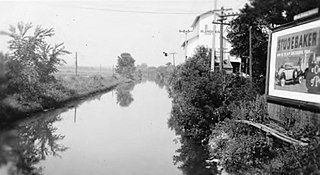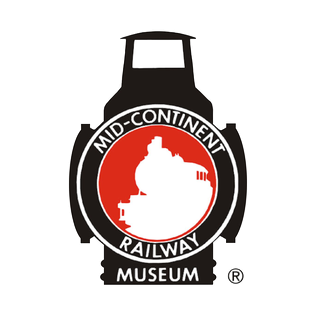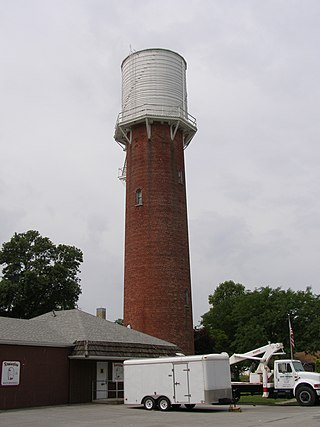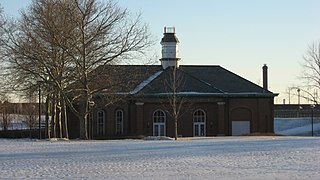
A water tower is an elevated structure supporting a water tank constructed at a height sufficient to pressurize a distribution system for potable water, and to provide emergency storage for fire protection. Water towers often operate in conjunction with underground or surface service reservoirs, which store treated water close to where it will be used. Other types of water towers may only store raw (non-potable) water for fire protection or industrial purposes, and may not necessarily be connected to a public water supply.

The Illinois and Michigan Canal connected the Great Lakes to the Mississippi River and the Gulf of Mexico. In Illinois, it ran 96 miles (154 km) from the Chicago River in Bridgeport, Chicago to the Illinois River at LaSalle-Peru. The canal crossed the Chicago Portage, and helped establish Chicago as the transportation hub of the United States, before the railroad era. It was opened in 1848. Its function was partially replaced by the wider and deeper Chicago Sanitary and Ship Canal in 1900, and it ceased transportation operations with the completion of the Illinois Waterway in 1933.

Kinmundy is a city in Marion County, Illinois, United States. The population was 733 at the 2020 census.

The Chicago Water Tower is a contributing property and landmark in the Old Chicago Water Tower District in Chicago, Illinois, United States, that is listed on the National Register of Historic Places. Built to enclose the tall machinery of a powerful water pump in 1869, it became particularly well known when it survived the Great Chicago Fire of 1871, although adjacent buildings burned to the ground.

The Mid-Continent Railway Museum is a railroad museum in North Freedom, Wisconsin, United States. The museum consists of static displays as well as a 7-mile (11 km) round trip ride aboard preserved railroad cars.

London Museum of Water & Steam is an independent museum founded in 1975 as the Kew Bridge Steam Museum. It was rebranded in early 2014 following a major investment project.

The Paxton Water Tower and Pump House are a historic water tower and pump house located at 145 S. Market St. in Paxton, Illinois.

The Lena Water Tower is a water tower located in the village of Lena, Illinois, United States. It was built in 1896 following two decades of problems with structure fires in the village. The current water tower is the result of a second attempt after the first structure proved to be unstable. The tower stands 122.5 feet (37.3 m) tall and is built of limestone and red brick. The current stainless steel water tank holds 50,000 gallons and replaced the original wooden tank in 1984. The site has two other structures, an old power plant building and a 100,000 US gallon reservoir. The Lena Electric Plant Building was constructed in 1905 and the reservoir completed in 1907. The Lena Water Tower was listed on the U.S. National Register of Historic Places in 1997; the reservoir was included as a contributing property to the listing.

The Falmouth Pumping Station is a historic water pumping station on Pumping Station Road in Falmouth, Massachusetts. The complex consists of an 1898 Queen Anne pumping station designed by Ernest N. Boyden, a low-lift pump and water treatment building built in 1993, a chlorination tank also built in 1993, and a house and garage added in 1932. The plant was built in response to rising demand for vacation properties and fire suppression, and continues to fulfill those functions today. The complex was listed on the National Register of Historic Places in 1998.

The Water Tower was built in 1897 by Challenge Wind and Feed mill Company of Batavia, Illinois. This is a rare wooden tank atop a brick tower type of water tower. Built on a limestone foundation, it is 140 feet (43 m) tall and about 20 feet (6.1 m) in diameter. The brick walls are 2 feet (0.61 m) thick.

The Benson Water Tower was a water tower located on Clayton Street in Benson, Illinois. The tower was built in 1891, in response to several serious fires in Benson; it supplied the village with water until 1985. The tall brick tower had a large wooden water tank on top. The tower was added to the National Register of Historic Places in 1987. It has since been demolished, and was delisted in 2020.
The Frenchville Railroad Station and Water Tank are a historic railroad museum property in Frenchville, Maine. The station and water tank were built in 1910 by the Bangor & Aroostook Railroad (B&A) and were added to the National Register of Historic Places on June 20, 1995. The station was retired in 1971. The water tower became obsolete in 1958 when the diesel locomotive replaced the steam locomotive. The Town of Frenchville purchased the water tank from Bangor & Aroostook Railroad and used it as a water reservoir for the fire department until 1981. The Frenchville Historical Society took over maintenance of the site in 1985.

The Beaumont St. Louis and San Francisco Railroad Water Tank is a railroad water tank or water tower constructed in 1875, in Beaumont, Kansas. It served the St. Louis, Wichita & Western Railway, and was used to refill the boilers of steam locomotives on that line. It was added to the National Register of Historic Places in 1993. A sign at the site claims it was the last water tank used in regular railway operations in the United States.

The Chillicothe Water and Power Company Pumping Station is a historic building on the northern side of Chillicothe, Ohio, United States. A Gothic Revival structure built in 1881, it was constructed to house the city's waterworks and power plant. Its architecture and its location in Yoctangee Park was chosen specifically in order to beautify the park as well as to have a location near other elements of the city's first waterworks, which were built at the same time as the pumping station.

Bardwell station was a historic train station at the city of Bardwell in the far western part of the U.S. state of Kentucky. Constructed in the late nineteenth century along the railroad's main line, it was the center of life for local residents and served as a significant maintenance site for the railroad. As a simple functional structure, the depot qualified for designation as a historic site in 1976, but it no longer stands.

The Crystal Spring Steam Pumping Station is a historic pumping station located at Roanoke, Virginia, in the United States. It was built in 1905, and is a one-story building constructed in common-bond brick. The building houses a Corliss-type pump made by the Snow Steam Pump Company in Buffalo, New York. At its peak, the pump provided 5,000,000 US gallons (19,000 m3) of water daily. It was in operation from 1905 to 1957, and was an important source of fresh water in Roanoke's early history.
The Beaumont St. Louis and San Francisco Railroad Retention Pond is a retention pond originally constructed by the St. Louis, Wichita, and Western Railway Company as a supply pond for the Beaumont St. Louis and San Francisco Railroad Water Tank. It served the St. Louis, Wichita & Western Railway, and supplied the water tank, which was used to refill the boilers of steam locomotives on that line. It was added to the National Register of Historic Places in 2011. From the year of construction until about 1955, when the railroad switched to diesel locomotives, this watering station was essential to railroad transportation.

West Washington Street Pumping Station is a historic pumping station located in Indianapolis, Indiana. It was built in 1870, and is a one-story, rectangular brick building. It was modified to its present form after 1909, and is 2/3 of its original size. It has a slate hipped roof topped by a square central tower and features distinctive brick detailing, and arched openings. The building served as the city's only water pumping station until 1890.

The Rutland Railroad Pumping Station is a historic water pumping facility at 43 Lake Street in the town of Alburgh, Vermont. Built in 1903, it is a rare example in Vermont of an early railroad-related water pumping facility. In use until the 1940s, it provided water needed for steam engines at rail facilities elsewhere in Alburgh. It is now owned by the town, and was listed on the National Register of Historic Places in 1999.

The Mills Tower Historic District is a nationally recognized historic district located in Iowa Falls, Iowa, United States. It was listed on the National Register of Historic Places in 1990. At the time of its nomination the district consisted of six resources, including two contributing buildings, and four non-contributing buildings. All of the buildings are associated with the Illinois Central Railroad (IC). The Dubuque & Sioux City Railroad, an affiliate of the IC, laid the first rail track to Iowa Falls in 1866. The following year the Iowa Falls & Sioux City Railroad, another IC affiliate, continued construction of the line to the west, and it reached Sioux City by 1870. The Burlington, Cedar Rapids and Northern Railway (BCR&N) by way of its affiliate the Cedar Rapids, Iowa Falls & North Western, entered Iowa Falls in 1880. Two years later it was expanded to the north and intersected with the IC main line, which required a controlled crossing. Little is known about this first crossing and what it contained.




















